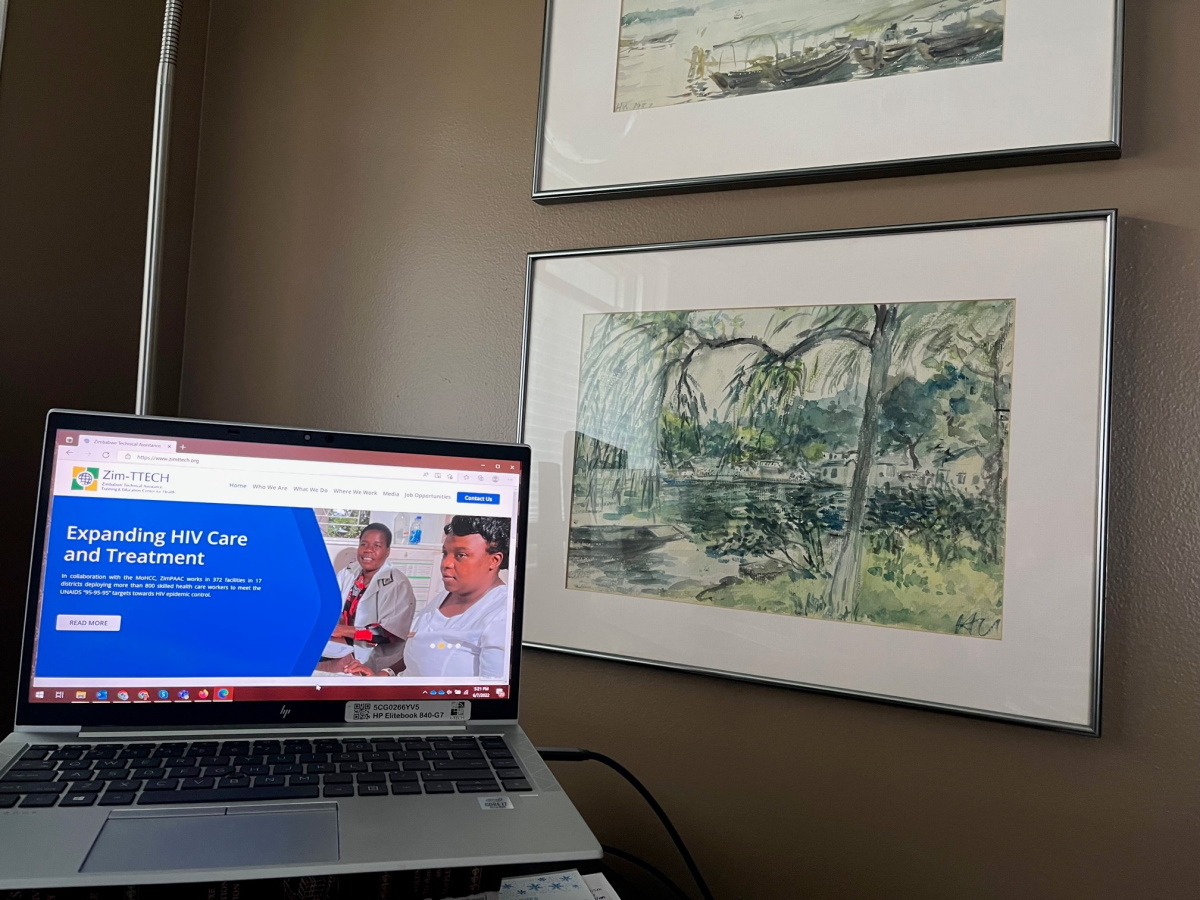Session 7: Self-Care and Collective Care in the Workplace
In this session we will explore self-care and collective care. You will focus on yourself and practice self-care strategies to improve your personal well-being. You will also learn about specific self-care and collective care strategies for the workplace that you can use and share with team members.
Getting Ready For This Session
- Remember to have your workbook and a pen or pencil handy.
- You will need about 75–80 minutes to complete the session.
Learning Objectives
By the end of this session, you will be able to:
- Define self-care and collective care
- Explain the importance of using care practices to increase morale and decrease burnout
- Explore sustainable self-care strategies that you enjoy and that are effective
- Identify methods for creating a caring workplace environment
Learning Activities
-
Introduction (5 min)
To get grounded into our final session about self-care and collective care in the workplace, let’s listen to Aletta Makotore.
Transcript

Congratulations! You made it to our final session about self-care and care in the workplace. In this session we will explore the topic of caring for yourself and others on your team. You will learn and practise specific strategies to develop your self-care toolbox and better support the individuals you supervise.
So, I want you to take a minute to think about how you are feeling in this moment. Write just one word in your workbook to capture how you feel. Be honest and capture exactly how you feel.
So, before we begin this session, if you are sitting at your desk, I’d like you to place both of your feet on the floor. Take a deep breath in and a full breath out. Notice how your body feels. Maybe you have some tension in your shoulders. Maybe you feel energetic to start to your day. No matter what you are feeling, I will guide you through a few stretches to awaken your body and bring you into the present moment.
We are doing it together now. Sit up right with your shoulders level and turn your head from left to right. You can repeat this movement a few times. Then lift both of your arms above your head. You can grab your right wrist with your left hand and lean your body to the left. Then alternate, grab your left wrist with your right hand and lean over to the right. Now, let’s end with shoulder raises. Lift both your shoulders up to your ears for three seconds and then release. Do this action two more times.
Thank you for caring for your body today.
AlletaRemember to write the word that describes how you feel in your workbook.
-
Pre-Session Assessment (5 min)
Let’s begin this session with a quick check of your knowledge and comfort around the topic of self-care and collective care. Each question will have a score for you to track in your workbook. Please track your scores as you go through this assessment, and make note of any content areas that you answered incorrectly. This exercise will help to identify gaps in knowledge and areas that need more attention as you go through the content in this session.
-
Activity 1: Box Breathing (5 min)
Throughout this session, you will practice three different self-care activities. Some of you may already be familiar with these activities and use them on a regular basis. For the rest of you, these activities will be new. At the end of this session, you will be able to identify activities that you like and add them to your self-care toolbox.
The first activity promotes active and steady breathing. Mindful deep breathing practices can help you lower your heartbeat and reduce your levels of stress and anxiety. Two benefits of these practices are that they can be quick and can be done anywhere.
- Before you begin the video, write down three words to describe how you are feeling in this moment. Write your words in your workbook.
“Box Breathing – 1 minute in length”, YouTube, uploaded by Conscious Works (2020) (Accessed 17 May 2022) - Now that you have completed this breathing exercise, write three words in your workbook to describe how you are feeling. Also, check if you notice a change from before you started the exercise. Write your response in your workbook.
-
Practicing Self-Care at Work (15 min)

Your individual well-being is valuable and valued. In this session, we define well-being as the ‘experience of health, happiness, and prosperity’1. You are your own individual before you are an employee or supervisor. Practicing self-care helps to support your physical, mental, emotional, and psychological health and well-being, by improving energy and concentration, increasing happiness, boosting your immune system, and reinforcing self-confidence.
Self-care practices are vital in both your personal and professional lives. In the workplace, self-care also benefits an organisation in a variety of ways. Regular self-care practices within the workplace can:
- Reduce individual levels of stress
- Reduce individual feelings of burnout
- Enhance overall productivity
- Improve innovation
- Increase satisfaction
- Increase retention
- Enhance teamwork and collaboration
- Reduce work-related conflicts
Ultimately, individual self-care is important for an organisation because self-care promotes health and well-being. Healthy employees are more likely to be productive and engaged.
As employees, we spend most of our days of the week in the office or other locations accomplishing tasks for work. Alongside the heavy demands of our work expectations, we must remember that many of us also have personal responsibilities outside of the workplace. Due to these competing priorities and responsibilities, as well as other environmental factors, you and individuals on your team may sometimes experience feelings of stress and burnout. Some levels of stress can be expected, and even motivating—for example, when you need to meet a short deadline for a project. However, chronic or long-term stress can lead to burnout; this should not be the norm in the workplace.
Burnout2 is a ‘state of emotional, mental, and often physical exhaustion brought on by prolonged or repeated stress.’ Burnout in the workplace can be caused by many factors, including working long hours, unclear job expectations, dysfunctional workplace dynamics, managing too many tasks at once, not having enough social and professional support, and work-life imbalance. An effective strategy for managing burnout is to prevent it from happening in the first place. Self-care is most effective as a daily or regular routine; it has less impact if used only during times of extreme burnout. Clear and open communication, well defined expectations and roles, and self-care practices can support these efforts. Although these issues may sound easy to address, they do take time to become habitual.
With our physical time and personal commitments to work and other life responsibilities, it is important to cultivate and use sustainable self-care strategies in the workplace.
The Indeed editorial team34 explained how to incorporate self-care in the workplace. Let’s explore these strategies:
-
1. Take care of your body
There are many actions you can take to care for your body while at work. Consider drinking more water, packing a nutritious lunch, and taking movement breaks. Drinking water and eating a healthy lunch will help you feel more energised throughout the day. In terms of movement, if you are able, you can take your breaks outside, schedule walking meetings, and stretch at your desk (we will give you a guided activity later in the session to help you do this).
-
2. Set personal goals
Identify and write out your goals for each workday or for the full week. By creating a clear list of what you need to prioritise, you can set realistic goals and celebrate small achievements. Make sure that your goals are SMART (specific, measurable, attainable, relevant, and timely).
-
3. Request time off
Time away from work is important. Think about your last vacation or days off from work. You may want to schedule some time off to rest, or to complete personal errands. Consider what you might want to do and schedule enough time away so that you can return feeling recharged. Avoid engaging in work activities while you are on vacation with family and friends.
-
4. Ask for feedback
In Session 5, we learned about giving and receiving feedback. Remember, you can also ask others for objective feedback instead of waiting to receive it. By asking for feedback, you can learn how you are performing. This can enhance your sense of security and improve your emotional well-being as you build on what is working well, and enable you to take corrective action where there are gaps.
-
5. Socialise with colleagues
Building relationships with team members can create feelings of joy and belonging. If you have the time and interest, you can start a conversation with your colleague(s) during a tea break or invite them to join you during a movement break. Light-hearted conversations can boost your mood and build strong connections. However, be mindful of your conversations so you don’t let confrontation trigger stress and unhealthy work relationships.
-
6. Limit your workload, when able
Although you may not be able to say no in every situation, utitlizing this skill can be beneficial to your well-being. If you have a full list of responsibilities, and a colleague asks you to help them with a task, you can say, ‘I do not have the time today, but I would be happy to help you with other tasks in the future. Please feel free to ask me again.’ When you recognise your personal capacity to complete tasks on time, you can work at a more relaxed pace. Understand your limits to avoid over-promising colleagues with tasks that you are not able to accomplish.
- 7. Decorate your personal space
-
8. Be open to learning new things
Learning5 and professional development is a form of self-care in the workplace. Learning enhances professional skills and boosts confidence. When it comes to learning, the best practise is to start small. Consider taking professional development courses to fill knowledge gaps identified through objective feedback from team conversations and performance appraisals, and thus to enhance your work performance.
-
9. Establish a healthy routine to end your workday
Consider using the last 10 minutes of your workday to review any notes, read emails, and prepare for upcoming meetings. This routine will help you to close out your day and prepare for the next. It may be helpful to include your own end of day habit. It could be a few deep breaths and a short visualization or physically shutting down your laptop. Use this end of day routine to create robust boundaries and achieve a healthy work-life balance.
You can use these strategies to take care of yourself at work. You can also share them with your team to promote their well-being. We will talk more about collective care later in this session.
-
Self-Reflection (5 min)
With a deepened understanding of self-care in the workplace, take a moment to reflect on the following questions and write your responses in your workbook:
-
Activity 2: Movement (5 min)
The second self-care activity in our session focuses on movement. Moving the body is important for both physical and mental health. For those of us who spend most of our days sitting at a desk and in front of a computer, organising specific times for movement can help us reach our goals.
Healthy movement encompasses a variety of activities, including walking, stretching, yoga, football, and even moving while seated.
Creating time for movement during the workday can be challenging. However, there are many activities that can be done in the office—even at your desk. The following video covers a short stretching practice that you can do at your desk. You are encouraged to follow the instructions and join along.
"The Whole U - Desk Yoga for Your Neck", YouTube, uploaded by UW (University of Washington), (2014), (Accessed 17 May 2022). After you have completed the activity, take a moment to consider the following questions:
-
Practicing Collective Care at Work (5 min)

Collective care in the workplace is about taking interest and responsibility in the well-being of those around you. Collective care is directly connected to self-care. For example, to effectively take care of others, it is important to take care of yourself. Similarly, demonstrations of care and concern for others give them permission to take care of themselves.
Your team members may not directly come to you for support if they are feeling burnt out, overwhelmed, or stressed. As a supervisor, you can use your communication and empathy skills to check in with your team members and promote self-care practices.
There are behaviours6 you can look for that may be signals of stress or burnout:
- Lack of energy, focus, and productivity
- Changes in behaviour, such as being late to work or forgetting to complete tasks
- Expressions of doubt
- Reduction in motivation or attention
- Lack of motivation and satisfaction in work
- Physical and psychological ailments, such as mood swings, irritability, back pain, headaches, and general malaise
- Feeling of loneliness and isolation, even when surrounded by colleagues
- Expressions of exhaustion
As a supervisor, you can model collective care for your team. When you notice these behaviours or hear explicit expressions of exhaustion from team members, you can offer support and feedback. You could say something like, ‘I’ve noticed a change in your behaviour lately; you don’t have to share any specifics, but I want you to know that I’m here if you need to talk. I know it’s a busy, stressful time, but I’m here to support you if you need it.’
Make sure to identify the specific change that you notice. You can offer concrete solutions to your team member that encompass the self-care strategies discussed in this session. These types of conversations provide wonderful opportunities to practice your empathy and open communication skills.
Your team members can also provide this type of support to one another, and to you. Caring for others will help build strong and trusting relationships, and even improve team dynamics.
-
Creating a Caring Workplace Environment (8 min)
Now that we have explored both self-care and collective care and their benefits to an organisation, let’s identify ways in which you as a supervisor can create a workplace environment that is supportive of these strategies.
Lead by example
As a supervisor, it is important to model self-care for your team members. Be aware of and address your own stressors before dealing with issues affecting your team. Often, your team will look to you for guidance and leadership. For example, if you rarely use your vacation time, you may create an unspoken expectation that taking time off is not encouraged. You can also talk openly with your team about your own self-care practices. When doing so, consider using expressive language to describe how you are feeling, and share the strategies that you use to take care of yourself. For example, in a meeting with your team you can say, ‘I’ve been feeling tired lately, which was a good reminder that I need to drink more water and get away from my desk and move around more.’ When you have specific conversations and identify individuals exhibiting signs of stress and burnout, engage them in confidence, and if need be, refer accordingly.
Conduct regular check-ins
In Session 4, Team Dynamics, you learned more about the benefits of regular meetings, formal or informal, with individual team members. You may choose to schedule a meeting if you notice changes in behaviour or signs of burnout. You might also notice expressions or signs of stress and burnout during a formal meeting. That would be a good chance to discuss well-being and self-care strategies.
Share specific mental and physical health resources
Share resources that can be accessed through work. At times, you or your team members may want or need outside mental health resources. Ensure that these resources are shared and accessible to all, such as the toll-free counselling line. Consider creating an internal document to post these resources.
These are just a few strategies you can use to establish a workplace culture where individuals can successfully practice self-care and collective care. You may have thought of additional ways you can create a caring environment in the workplace, you can add these to your toolkit and continue adding to these as you develop in your role as a supervisor.
-
Resilience (8 min)
Resilience7 can be defined as the capacity to address or recover from unexpected challenges or hardships in your life. Resilience is another valued skilled in the workplace, one that is necessary for overall positive physical and mental health. It is important for continued engagement and success in ever-changing environments.
Within the workplace, resilience helps you to resolve problems as they arise, correct mistakes, ask for help, and maintain an optimistic mindset.
Let’s talk about four practices you can use to cultivate sustainable resiliency.
The first is to break down the problem. Session 6 addressed solving problems as a supervisor. When unexpected challenges arise, it is natural to feel overwhelmed. You may also feel uncertain about how to start addressing the problem. Here it is helpful to recall the problem-solving strategies you learned. Another helpful practice is to break down the problem into more manageable components.
The second is to build and use your support network. Cultivating trusted relationships is a concrete way to build a support network. Recall the trust-building strategies discussed in Session 4, Team Dynamics. When thinking about resiliency, it is beneficial to curate a robust network of individuals who can advocate for you and support you in the workplace. Recognise that as you identify people to include in your network, you may also be serving as a support person in their network.
The third is to know your limits. Understanding and respecting your personal capacity to effectively complete tasks is a necessity for workplace endurance or resilience. When we take on too much, it is easy to feel overwhelmed and stressed, making it more difficult to manage and complete tasks well. Although it can be challenging to do, it is important to be honest with yourself and others about your capacity to take on additional tasks or complete tasks within a short timeframe. Know that your capacity can and will change depending on your workload and other personal factors.
The fourth is to take care of yourself, which connects back to this session. Regularly using self-care practices can help you understand how you are feeling and identify what you need to do to support your overall health and well-being, both in that moment and beyond.
Being resilient does not mean you don’t experience stress and difficult situations, rather you are able to take control of how you react and respond, and potentially grow after a challenge.
-
Activity 3: Meditation (10 min)

The third and final self-care practice in this session is meditation. Meditation is a self-care practice that anyone can do. Meditation practices create opportunities for self-reflection, mindfulness, and relaxation. This practice can be done in silence, or with pre-recorded guided instruction. While some may see meditation as a religious practice, for the purposes of this training it is a non-religious activity that is used to manage stress.
The following is one example of a guided meditation. Before you begin, make sure you have the space to sit or lie in a comfortable position and can set aside time without any distractions. Follow the instructions and focus on the thoughts in your mind and the feelings in your body.
"Stress Check - 5 minutes", Soundcloud, Uploaded by University of Washington (2020), (Accessed 17 May 2022). Now that you have completed the meditation, consider the following questions:
-
Action Plan (10 min)
Review the self-care and collective care strategies and practices presented during this session.
Using the Action Plan form in your workbook, create a workplace self-care action plan for the next week. Write down all the days of the week. Each morning, write down how you are feeling. Then, depending on what you have written, write down a self-care practice that you will perform that day. Make sure to include a specific time to complete this activity.
Self-care strategies are most effective when they are completed often. Please identify practices that you enjoy doing—and start small.
Within the action plan, designate a time to share your plan with your team members. You can talk about the training assignment and encourage them to create their own self-care action plans.
-
Post-Session Assessment (5 min)
Now that you have completed this session, let’s take time to check your knowledge and comfort about self-care and collective care. Please track your scores as you go through this assessment, compare them with your pre-test scores, and make note of any content areas where you answered incorrectly.
-
Summary (2 min)
Congratulations on completing this session and the self-study portion of the course! In this session you learned about self-care and collective care, practiced three different self-care strategies, and explored ways to promote self-care and collective care in the workplace.
Consider whether you are feeling confident to use some of the skills throughout your day when you notice you are feeling stressed.
Take a minute to think about how you are feeling in this moment and write one word in your workbook. How is it different than when you started this session?
If there are components in this session that you would like to learn more about, refer to the Resources section below.
-
Resources
Title/Source File/Link Mindfulness and Meditation Recordings and Handouts Mindfulness Practice Cards Click to open file. -
Body Scan Meditation
"Body Scan Meditation", YouTube, uploaded by Conscious Works (2021), (Accessed 17 May 2022)
Click to open file. 5, 4, 3, 2, 1 Grounding Practice Click to open file. -
Cultivating a Loving Heart Meditation
"Cultivating a Loving Heart Meditation", Soundcloud, uploaded by The Whole U (2019), (Accessed 17 May 2022)
Click to open file. Movement Recordings and Handouts Yoga Practice Cards Click to open file. -
Desk Yoga for Hips
"The Whole U - Desk Yoga for Hips", YouTube, uploaded by UW (University of Washington) (2014), (Accessed 17 May 2022)
Click to open file. -
Desk Yoga for Arms and Sides
"The Whole U - Desk Yoga for Arms and Sides", YouTube, uploaded by UW (University of Washington) (2014), (Accessed 17 May 2022)
Click to open file. Webpages (note that you will need an internet connection) Self-Care Toolkit | The Whole U (uw.edu) Insight Timer Keywords For Searches: mindfulness meditation, desk yoga, grounding practice, visualisation meditation, walking meditation
Footnotes
- What Is Well-Being? Definition, Types, and Well-Being Skills | Psychology Today
- Burnout | Psychology Today
- 14 Ways You Can Implement More Self-Care at Work | Indeed.com
- The 6 Ways Young People Can Incorporate Self-Care At Work In 2022 (forbes.com)
- The Ultimate Form of Workplace Self-Care: Learning (linkedin.com)
- 10 Clear Signs Of Impending Burnout At Work (And How To Overcome It) (forbes.com)
- What Is Resilience: Top 5 Tips To Improve Your Resilience - YouTube
-
Body Scan Meditation





